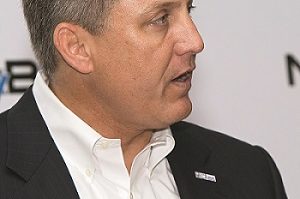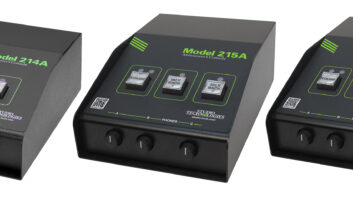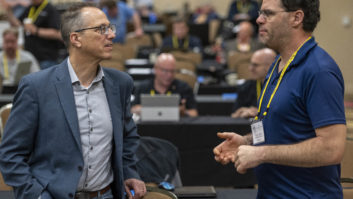
Association of Public Radio Engineers board member David Antoine has provided us with this summation of the happenings from the second day of the Public Radio Engineers Conference, taking place as a prelude to the NAB Show.
The Association of Public Radio Engineers held its annual conference at the Tuscany Suites in Las Vegas, April 20–21. We had 92 registered attendees this year from across the public radio spectrum.
A comprehensive panel discussion on metadata using MetaPub via PRSS and NPR opened Friday’s conference. Featuring panelists NPR’s David Gray, Megan Williams, Matt Walther and KNPR’s Phil Burger, they discussed new methods for accurate metadata being displayed on radios.
Telos Alliance pros Kirk Harnack and Joe Talbot presented a paper on using VoIP in broadcast. Talbot provided some great examples and illustrations of practical VoIP implementation in the real world. Traditional POTS broadcast is becoming history. VoIP offers better quality and flexibility if the IP service is available.
Visual radio was an interesting topic presented by Joe Tymecki of Vermont Public Radio. Adding a video/visual component to a radio broadcast can enhance the engagement of the listening audience, he explained and offered tips and practical ways for every budget to add video to audio-only broadcasts.
PRSS was out in force and provided an update on their services, in particular the future single transponder system. June 1, 2018, marks the move to a single transponder, while distribution will move to some terrestrial-based content.
Eagle Hill Consulting, on behalf of the Corporation for Public Broadcasting, distributed a tech survey for public broadcasting stations. They shared very preliminary results and trends they discovered from the survey results.
Jerry Olson of Spokane Public Radio shared highlights of their recent studio build project, housed in an old landmark firehouse. It was a doubly-interesting project given the building was also a historic preservation site. Jerry shared with the audience some of the challenges and the solutions he ran into while constructing a new AoIP facility within an old building.
David Layer of NAB’s Technology Office presented a paper on the Digital Dashboard, now available in most new cars on the market. The car radio has evolved into the “Connected Vehicle Radio,” with internet as well as RF over the air connections to music, media and data.
Streaming apps on phones are becoming a more important source in the car, he noted. He added that Xperi and DTS are heavily pushing HD Radio.
Lawo’s Michael Dosch talked about new radio console designs that allow moves away from the traditional “multifader and sheet metal” approach to console design. He proposed the usage of touchscreen technology, the graphical “skin” and “profile” approach to console or studio source operation. Concerns about the need for visual interaction were raised during the Q&A, but overall, attendees seemed intrigued by the flexible potential it could represent.
Melodie Virtue of the Garvey Schubert Barer law firm, discussed various legal Issues that are facing public radio broadcasters.
Top of her list was drones, and she covered the legal requirements and FAA rules governing the usage of drones in U.S. airspace. She also touched upon how the TV repack may change a lot of things, including the fact that FMs that share sites with TV stations could be impacted, but not compensated in the way the TV stations have been.
She also suggested that stations think about existing laws that are no longer relevant, and consider flagging them to the FCC, to take advantage of the deregulatory movement expressed by the Trump administration and Chairman Ajit Pai’s FCC.
Cory Edwards from Dielectric discussed the company’s 75 years of dedication to both the TV and FM industries, and pointed out that while they are most known for TV transmission systems, they also provide a line for LPFM and FM translators. They are always looking for ways to lower costs, and he explained that aluminum is getting used more often, but it has to be mixed in correctly.
The APRE closed out PREC 2017 with its annual awards dinner. This year’s honoree Dan Mansergh graciously accepted the award while in the company of peers, attendees, PREC sponsors and our three 2017 scholarship winners.












